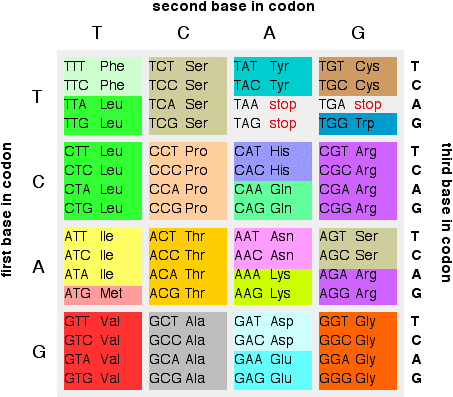Editing DNA holds great promise, but like all new technologies that are still in their infancy, it’s still slow, expensive and hard to use. However, researchers are developing genome-scale editing tools that might aid in quickly and easily rewriting the genomes of living cells. Harvard-based researchers have developed a new way to edit the genome of living bacteria.
What they did, was replace one three-letter sequence (or a codon) in the genome with another one (for all codons, see figure 1). Codons act as code (what’s in a name, huh?) for amino acids, or as stop signal. Using E. coli, one of biology’s most popular model organisms, the researchers identified all TAG codons (stop signals), and, aided by viral enzymes, replaced them with TAA codons (another stop signal). By submerging the bacteria in water, carrying the DNA bits and viral enzymes, the DNA was able to pass through the bacteria’s cellular membrane after an electric shock, a process known as multiplex automated genome engineering (or MAGE).

Figure 1: All 64 codons., with the abbreviation of the amino acid the code for, or 'stop' for a stop signal. (Source: chemguide)
So, now the TAA codons have entered the bacteria, but how did they replace the TAG codons? By encouraging sex. Conjugation, the bacterial equivalent of sex, involves an exchange of DNA fragments without producing offspring. Through the systematic pairing of different bacteria, the research team came closer, step by step, to the eventual strain containing only TAA stop signals in the genome. At the moment, the emergence of the final strain is imminent. The technique is called conjugative assembly genome engineering (or CAGE) (for a schematic illustration of the process, see figure 2). The advantages of CAGE are that it is faster (roughly five weeks) and cheaper than other techniques.

Figure 2: Schematic Illustration of CAGE.
(Source: Discover Blogs - Not Exactly Rocket Science)
This whole-genome editing (potentially including the incorporation of new, synthetic amino acids) opens up a lot of possible options, such as adding functionality to a cell by encoding for useful new amino acids, or preventing cross-contamination between modified organisms and wild ones, or establishing multi-viral resistance, and so on.
Of course,further development and research is needed, but this story will undoubtedly be continued…
Reference
Isaacs, F.J.; Carr, P.A.; Wang, H.H.; Lajoie, M.J.; Sterling, B.; Kraal, L.; Tolonen, A.C.; Gianoulis, T.A.; Goodman, D.B.; Reppas, N.B.; Emig, C.J.; Bang, D.; Hwang, S.J.; Jewett, M.C.; Jacobson, J.M. and Chruch, G.M. (2011). Precise Manipulation of Chromosomes in Vivo Enables Genome-Wide Codon Replacement. Science. 333(6040), pp. 348 – 353. Doi: 10.1126/science.1205822.





Comments